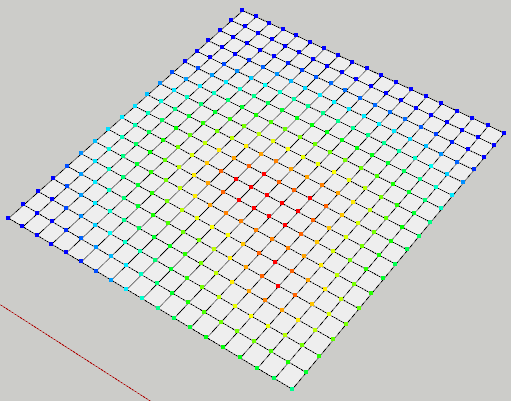Colours to illustrate range
-
Given a value within a given range range - say 0-100:
how would you return a colour between these colour ranges?
255, 000, 000 255, 255, 000 000, 255, 000 000, 255, 255 000, 000, 255Top (red) would be 100
Bottom (blue) would be 0I know I could get a result if I split the range into five segments and did a number of if-else statements. but is there a more efficient/cleaner method?
-
Five case/when statements with three nested case/whens seems the way ?
Unless you have a clever matrix manipulation way ? -
-
Maybe Color.blend would help shorten up the code to 4 states?
blue = Sketchup;;Color.new('blue') bluegreen = Sketchup;;Color.new(0, 255, 255) green = Sketchup;;Color.new('green') redgreen = Sketchup;;Color.new(255, 255, 0) red = Sketchup;;Color.new('red') # assuming v is (0..100) case v c = v / 100.0 when (0..25) color = blue.blend(bluegreen, c) when (25..50) color = bluegreen.blend(green, c) when (50..75) color = green.blend(redgreen, c) when (75..100) color = redgreen.blend(red, c) end -
` def test_clr(value = 45, max = 100, min = 0)
clr = []
clr << Sketchup::Color.new(255,0,0)
clr << Sketchup::Color.new(255,255,0)
clr << Sketchup::Color.new(0,255,0)
clr << Sketchup::Color.new(0,255,255)
clr << Sketchup::Color.new(0,0,255)n = value / ( (max - min) / 5.0 )
index = n.to_i
ratio = n - indexc1 = clr[index-1].blend(clr[index], ratio)
def` -
hm... fails when given the max value...

-
This works - with out of range recovery.
def test_clr(value = 45, max = 100, min = 0) clr = [] clr << Sketchup;;Color.new(255,0,0) clr << Sketchup;;Color.new(255,255,0) clr << Sketchup;;Color.new(0,255,0) clr << Sketchup;;Color.new(0,255,255) clr << Sketchup;;Color.new(0,0,255) clr << Sketchup;;Color.new(0,0,255) value = [min, value].max value = [max, value].min n = value / ( (max - min) / 5.0 ) index = n.to_i ratio = n - index c1 = clr[index-1].blend(clr[index], ratio) endBut a simple switch might still be neater...

-
And bugged when min is not 0. ... ok - I'm no making for an elegant solution. KISS calling?
-
Ok - This one is the final deal. Easily extendible with other colour ranged by changing the array.
def value_to_color(value = 0, max = 100, min = 0) # Colours to translate to. First is max, last is bottom. # NOTE; last must appear twice! clr = [] clr << Sketchup;;Color.new(255,0,0) clr << Sketchup;;Color.new(255,255,0) clr << Sketchup;;Color.new(0,255,0) clr << Sketchup;;Color.new(0,255,255) clr << Sketchup;;Color.new(0,0,255) clr << Sketchup;;Color.new(0,0,255) # Cap value to range. value = [min, value].max value = [max, value].min # Calculate what colours to blend between and the blending ratio. n = (value-min) / ( (max-min) / (clr.length-1.0) ) index = n.to_i ratio = n - index #puts [n, index, ratio] # DEBUG return clr[index-1].blend(clr[index], ratio) endSketchup.active_model.selection[0].material = value_to_color(30, 60, 20) -
weeeell, this is the really final deal! really!
def self.value_to_color(value = 0, max = 100, min = 0) # Colours to translate to. First is max, last is bottom. clr = [] clr << Sketchup;;Color.new(255,0,0) clr << Sketchup;;Color.new(255,255,0) clr << Sketchup;;Color.new(0,255,0) clr << Sketchup;;Color.new(0,255,255) clr << Sketchup;;Color.new(0,0,255) # Cap value to range. value = [min, value].max value = [max, value].min # Calculate what colours to blend between and the blending ratio. n = (value-min) / ( (max-min) / (clr.length-1.0) ) index1 = n.to_i index2 = [index1+1, clr.length-1].min ratio = n - index1 #puts [value, n, index, ratio].inspect # DEBUG return clr[index2].blend(clr[index1], ratio) endI had confused how the blend weighting worked. Fixed. +some cleaning up.

-
Very cool Thom, thanks for posting this. Its something that has crossed my mind recently. I'll be sure to look through your code,
Chris
-
I've got this snippet in a top secret little project I'm working (ok, well its top secret but I've shared it with quite a few other people, so its not that top secret). Anyhow, the code works great Thom, but I only just recently realized it does not cover the entire range of colors. To get it to come full swing back to red, one woul need to add the lines:
clr << Sketchup::Color.new(255,0,255) clr << Sketchup::Color.new(255,0,0)to the end of the other similar lines so that it adds the magenta color to the array and finally back to red. Then you have a true full spectrum represented in this lovely gradient.
Thanks again Thom!
Chris
-

Advertisement







